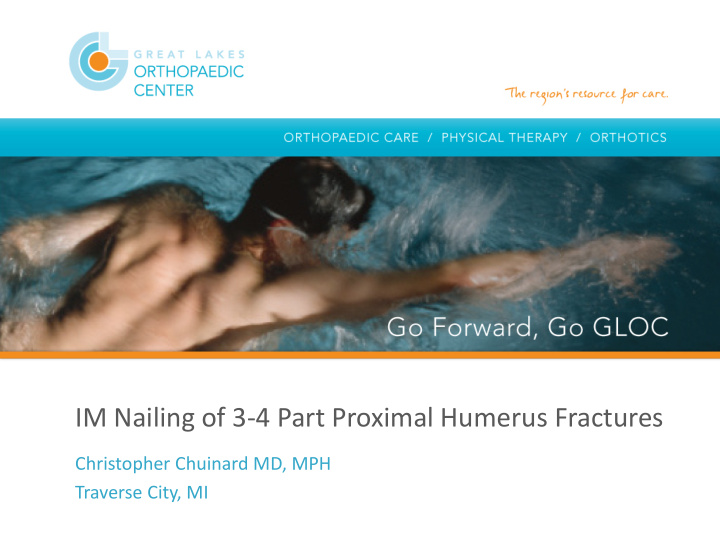



IM Nailing of 3-4 Part Proximal Humerus Fractures Christopher Chuinard MD, MPH Traverse City, MI
Disclosures Shoulder Innovations Royalties Consultant Rotation Medical Consultant Research Support Speaker DJO Consultant WMT Patent Royalties Consultant Research Support • Boileau/Hatzidakis – Royalties for Nail
What’s Wrong with Treatment of Proximal Humeral Fx?
Perc Pinning: 62 yo smoker
Its doable, but hard
Secondary Surgery
Plating for 3 & 4 Part Fx Humeral Head Based Fixation = No or Poor Tuberosity Fixation
Issues of Plating Screws parallel to the fracture plane
AO Biomechanics • Screws must be perpendicular to the fx line (not parallel)… (AO) Perpendicular Screw Screws Parallel to Fx line Placement do not fix tuberosities
Issues of Plating Blood Supply Disruption = Increased Risk of AVN
3 & 4-Part Fractures
3 & 4-Part Fractures High Complication Rate
What’s w rong w ith Current IM Nail Design?
Current IM Nails Design Too Long Not centered Proximal Bend & Too Big in diaphysis = Cuff Tear = Nonunion = Malunion
Issues of Current IM Nail Designs No Locking Humeral Head-based Fixation Mechanism
Current IM Nails Design Humeral Head based fixation GT GT LT . Tuberosity migration !
Current IM Nails Do NOT fix the GT !!!... (= Humeral Head screw patterns) GT GT Tuberosity Migration = 3 tendons Tear = Shoulder Pseudoparalysis
Errors of Past Nail Designs
3 & 4-Part Fractures What is the worst complication for patients?... GT migration? HH necrosis? or
Hemi is the ultimate AVN
Sadly, Many Hemi’s are Losers
What’s New w ith Aequalis IM Nail Design?
New Aequalis Nailing Concept Tuberosity Fixation Head-only Fixation w/Head Support
New Aequalis Nailing Concept Tuberosity Oriented Screw Pattern = Perpendicular to Fx Line
New Aequalis Nailing Concept Straight, Short, Small Nail No violation of Tuberosity fixation supraspinatus w/Locking Screws tendon
New Aequalis Nailing Concept Proximal screws captured Screw Locks inside the Nail in Nail Diaphyseal Centering Divergence of 0° : Amplitude of motion > 4 mm Divergence of 5° : Amplitude of motion 2,5 mm Divergence of 20° : Amplitude of motion 0,5mm
I don’t always use a nail, but when I do, it’s an Aequalis
Percutaneous Approach Posterior (Neviaser) Portal = Varus displacement Anterior Portal = Valgus displacement P. Boileau
Anterior / AC joint (Neviaser portal) For Translated / valgus deformity for Varus deformity
3 & 4-PART FRACTURES Open Superolateral approach
3 & 4-Part Fractures Superolateral Approach++ Courtesy : Dr Cuny
3 & 4-Part Fractures • Vertical Fracture is POST to the Groove • Horizontal Traction of RC Muscles 3 GT 2 1 LT 4 P. Boileau
3 & 4-Part Fractures Reduction Diaphysis Lift-up humeral head ‘‘close the book’’ Derotation
3 & 4-Part Fractures Temporary pining may be needed
4-Part Valgus Fracture GT LT No screws in humeral head needed
No Humeral Head Fixation Needed …to get a good result!
4-Part Fracture Dislocation 4 Part Fracture Dislocation 12 Months Post-Op Female 27 yo calcar screw (head support) Courtesy : Dr A. Hatzidakis
Take-Home Messages
IM Locked Nail Biological Biomechanical advantages advantages
3 & 4-part Fractures
Whatever the fracture… Brace in IR IR of diaphysis Brace in NR NR of diaphysis
Conclusion: IM Nail Benefits of Pinning Benefits of Plating & (Locking Technology) (minimal soft-tissue dissection) … w ithout the draw backs and complications of either technique!
Hatz 4Part Fx Aequalis IMNCase Pre-Intra-PostOp XR’s 10/17/10
Preoperative Radiograph Review
1 st Intraoperative AP View with Traction Calcar reduces, indicating intact medial periosteal hinge
AP View after “Head Lift” and Tuberosity “Pull-Down” Near anatomic reduction Humeral head lifted with • Cobb/Periosteal elevator Suture or dental pick placed • in greater tuberosity to pull traction laterally
Greater Tuberosity Humeral Head Reduction Held with 2.5mm terminally threaded Steinmann Pin
Placing Guide Pin (For Nail) Insertion
Nail Insertion Over Guide Pin
Outlet View
1 st Greater Tuberosity Screw Placed: Fixes tuberosity and supports anteromedial humeral head
Second Greater Tuberosity Screw
Final Intraoperative XR’s
One Week Postoperative Radiographs Greater tuberosity Lesser tuberosity Shaft comminution
One Week Postoperative Radiographs Note early controlled impaction at distal screw, humeral head and greater tuberosity fracture sites
New Aequalis Nailing Concept • Nail: Straight, Small, Short • Tuberosity-based Fixation • Locked Screws • Benefits of minimal tissue disruption – Percutaneous approach option – Preserves blood supply – Avoids the complications of plating and traditional nail designs
Thank You!!! cchuinard@hotmail.com
Recommend
More recommend